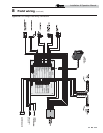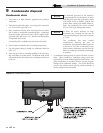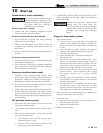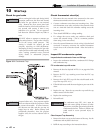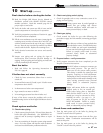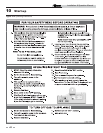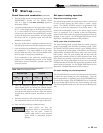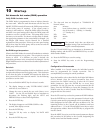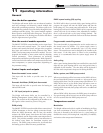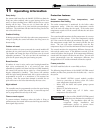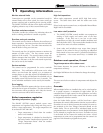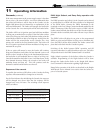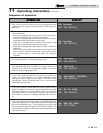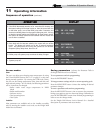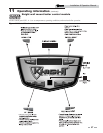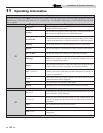
Installation & Operation Manual
51
11 Operating information
General
How the boiler operates
The Knight wall mount boiler uses an advanced stainless
steel heat exchanger and electronic control module that
allows fully condensing operation. The blower pulls in air
and pushes flue products out of the boiler through the heat
exchanger and flue piping. The control module regulates
blower speed to control the boiler firing rate. The gas valve
senses the amount of air flowing into the boiler and allows
only the right amount of gas to flow.
How the control module operates
The SMART SYSTEM control module receives input from
boiler sensors and external inputs. The control module
activates and controls the blower and gas valve to regulate
heat input and switches the boiler, Domestic Hot Water
(DHW), and system pumps on and off as needed. The user
programs the module to meet system needs by adjusting
control parameters. These parameters set operating
temperatures and boiler operating modes. Boiler operation
can be based on boiler outlet water temperature, boiler inlet
water temperature, or system temperature, depending on
the parameter setting.
Control inputs and outputs
Room thermostat / zone control
This input tells the boiler to provide water for space
heating.
Domestic Hot Water (DHW) tank thermostat
This input tells the boiler to provide water for heating an
indirect DHW tank.
0 - 10V input (set point or power)
The Knight wall mount boiler can be controlled by a
Building Management System (BMS) using a 0 - 10 vdc
signal. The control can be configured by the installer to use
this signal to either control set point or firing rate.
DHW priority
The SMART SYSTEM control module allows connection of
a DHW thermostat to the low voltage connection board.
When the DHW thermostat calls for heat, the module
activates the DHW pump, shuts down the boiler pump,
and immediately sets the target outlet water temperature to
180°F. This provides automatic priority heat allocation to
the indirect water heater for maximum response and
recovery. The DHW pump continues for 30 seconds after
the heating cycle to deliver the most possible heat.
DHW / space heating (SH) cycling
If a DHW call for heat is received while a space heating call is in
progress, the control will start the DHW pump and shut the
boiler pump off. The system pump will remain on. If the space
heating call is still active while the DHW call is in operation, the
control will wait for 30 minutes (time adjustable by installer)
then it will switch back to the space heating demand. The
control will switch back and forth until one of the heat demands
end.
Programmable controlling sensor
The control module is programmed to use the outlet sensor as
the control sensor by default. If a system supply sensor is
connected, the control automatically uses it as the control
sensor. The control sensor can be changed by the installer to the
inlet sensor. If the inlet sensor is chosen as the controlling
sensor, it is recommended that the system supply sensor be
installed.
Anti-cycling
After a space heating demand has been satisfied, the control will
delay the next space heating call for a set time period (time is
adjustable by the installer). The time delay will be bypassed if
the inlet water temperature drops too far during the delay.
Boiler, system, and DHW pump control
When a space heating call for heat starts and no DHW call is on,
the system and boiler pumps are turned on. As long as the space
heating call for heat is on, the system pump will remain on. If a
DHW call for heat is on, the boiler pump will wait to turn on
until just before the DHW pump turns off. After the space
heating call for heat ends, both pumps will run for an additional
period of time.
When a DHW call for heat starts, the DHW pump is turned on.
If a space heating call for heat was on, the boiler pump will turn
off a few seconds after the DHW pump turns on.
Temperature control
Modulation
The Knight wall mount boiler is capable of modulating its firing
rate from a minimum of 20% to a maximum of 100%. The
firing rate is dictated by the call for heat (i.e., space heating or
domestic hot water), the heating load, ramp delay (if enabled),
and various other temperature limitations.



